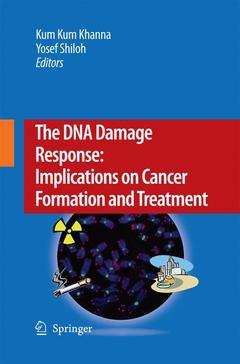The DNA Damage Response: Implications on Cancer Formation and Treatment, 2009
Langue : Anglais
Coordonnateurs : Khanna Kum Kum, Shiloh Yosef

The ?eld of cellular responses to DNA damage has attained widespread recognition and interest in recent years commensurate with its fundamental role in the ma- tenance of genomic stability. These responses, which are essential to preventing cellular death or malignant transformation, are organized into a sophisticated s- tem designated the ?DNA damage response?. This system operates in all living organisms to maintain genomic stability in the face of constant attacks on the DNA from a variety of endogenous by-products of normal metabolism, as well as exogenous agents such as radiation and toxic chemicals in the environment. The response repairs DNA damage via an intricate cellular signal transduction network that coordinates with various processes such as regulation of DNA replication, tr- scriptional responses, and temporary cell cycle arrest to allow the repair to take place. Defects in this system result in severe genetic disorders involving tissue degeneration, sensitivity to speci?c damaging agents, immunode?ciency, genomic instability, cancer predisposition and premature aging. The ?nding that many of the crucial players involved in DNA damage response are structurally and functionally conserved in different species spurred discoveries of new players through similar analyses in yeast and mammals. We now understand the chain of events that leads to instantaneous activation of the massive cellular responses to DNA lesions. This book summarizes several new concepts in this rapidly evolving ?eld, and the advances in our understanding of the complex network of processes that respond to DNA damage.
DNA Damage Sensing and Signaling.- Signaling at Stalled Replication Forks.- An Oncogene-Induced DNA Replication Stress Model for Cancer Development.- Cellular Responses to Oxidative Stress.- Cell Cycle Regulation and DNA Damage.- Chromatin Modifications Involved in the DNA Damage Response to Double Strand Breaks.- Telomere Metabolism and DNA Damage Response.- DNA Double Strand Break Repair: Mechanisms and Therapeutic Potential.- DNA Base Excision Repair: A Recipe for Survival.- DNA Damage Tolerance and Translesion Synthesis.- Nucleotide Excision Repair: from DNA Damage Processing to Human Disease.- Chromosomal Single-Strand Break Repair.- Mouse Models of DNA Double Strand Break Repair Deficiency and Cancer.- Cancer Biomarkers Associated with Damage Response Genes.- Linking Human RecQ Helicases to DNA Damage Response and Aging.- Single-Stranded DNA Binding Proteins Involved in Genome Maintenance.- The Fanconi anemia-BRCA Pathway and Cancer.- BRCA1 and BRCA2: Role in the DNA Damage Response, Cancer Formation and Treatment.
Offers up-to-date and comprehensive review of latest advances in DNA damage sensing, signalling and repair field Describes current bottlenecks and future directions Discusses the relationship between DNA damage repair and cancer Written by active investigators who have made important contributions in their respective areas
Date de parution : 11-2014
Ouvrage de 449 p.
15.5x23.5 cm
Date de parution : 11-2009
Ouvrage de 449 p.
15.5x23.5 cm
Thèmes de The DNA Damage Response: Implications on Cancer... :
© 2024 LAVOISIER S.A.S.



